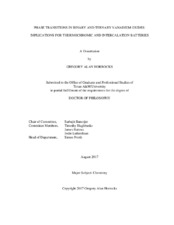| dc.description.abstract | The implications of climate change and resource scarcity stand to impose great strain on society, and require the development of novel ways to conserve and store energy. Due to the large portion of energy use accounted for the heating and cooling of buildings worldwide, thermochromic coatings offer promise for reducing energy footprints. Vanadium dioxide has long been a material of interest because of the intrinsitc metalinsulator transition wherein the material switches between a low-temperature, insulating, monoclinic phase (EB = 0.6 eV, infrared transparent) and a high temperature, metallic, tetragonal phase (infrared reflective). In this work we present the development of a scalable synthesis of extremely high quality vanadium dioxide nanoparticles, exhibiting superior a superior metal-insulator transition comparable to the highest quality films produced via molecular beam epitaxy.
In the field of energy storage, high energy and power density batteries are imperative to help drive the electrification of the transportation industry as well as for grid-level storage. However, there are many issues with current state-of-the-art Li-ion battery technologies including high cost, poor high rate performance, and safety concerns that hinder large scale adoption. However, the mechanisms governing cation transport and phase formation in battery host materials are not well understood. The study of these mechanisms is further complicated by their non-equilibrium nature, requiring multiple modes of characterization that combine theoretical calculations with geometric and electronic structure determination across multiple length scales. In this work, we have used chemical lithiation as a Li-ion insertion tool to study the mechanism of lithium insertion and diffusion through substrate free nanowires and nanoplatelets of vanadium pentoxide. Specifically, we have examined the dependence of these properties on particle size. Systematic studies utilizing X-ray diffraction, Raman spectroscopy, X-ray absorption spectroscopy, and scanning transmission X-ray microscopy have allowed us to identify the formation of two-phase mixtures upon Li-ion insertion. Combining these measurements with first principles calculations has allowed us to determine the mechanistic origins of this phase separation, and suggest that the barrier to diffusion of Li-ions through layered vanadium pentoxide arises from the formation of a small polaron upon Li-ion insertion. Understanding the mechanisms by which lithium mobility through the layered vanadium pentoxide structure is impeded has allowed us to develop a novel polymorph of vanadium pentoxide that minimizes the strength of the polaronic confinement. By replacing the layered framework with one-dimensional tunnels that provide a more rigid framework and spread the localized electron, we have achieved facile, fast, single-phase lithium insertion and removal. | en |


